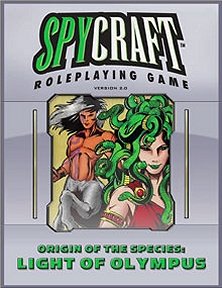
The base concept of the Origin of the Species series is to enable the use of species other than human in your Spycraft 2.0 game. It doesn't matter why you want them there or how you intend to use them, you'll get all the information you need to create characters - be they player-characters or NPCs. It's up to you to provide a rationale for why they exist, what they are doing and how they actually become material to your game, there's none of the background 'fluff' that many sourcebooks provide. That's good in that it gives you a completely free hand, but the downside is that you have to make it all up for yourself.
In Light of Olympus, various species from Greek mythology are provided - centaurs, gorgons, fauns and tritons. While you have, as already discussed, to decide why they are there in the first place, there's a wide-ranging discussion that provides many alternatives from them being quite normal and integrated into society to the products of crazy experiments by mad scientists or alien invaders that just happen to look like creatures out of classic Greek mythology so got given appropriate names. Of course, you may decide that only one of these species is present, you do not have to take the lot.
The discussion also covers the underlying way in which species have been designed (this discussion is common to all Origin of the Species products). Basically any species is defined by how much it differs from a 'human standard' - some are pretty similar and others are wildly different. The primary example used is that of a medic attempting to treat such a creature. If you have spent the better part of a decade learning how to treat human beings, you might be able to cope reasonably well - at least with basic first aid - with a centaur patient, but a gorgon or triton might well throw you. Of course a medically-trained member of that species is going to be just as baffled by a human patient.
Getting down to business, the core characteristics of each of the four species presented here are listed. Centaurs we probably all know as halfman half horse, tritons are merfolk with a human top half and a fish tail, fauns or satyrs are very similar to humans except they have furry legs, horns and cloven feet, and then there's the gorgons - human except that their hair is replaced with a mass of snakes. Gorgons don't, at least initially, turn you into stone at a glance, but those snakes are venomous. Merfolk don't get around well on land but swim well and breathe underwater.
There are some specialties to choose from and a master class for each species to aspire to, and a wide arrangement of feats most of which are associated with a given species. Gorgons get a new Combat Action, the gaze attack, as well. There is a collection of fully-developed NPCs to give you ideas, as well as all the tables and notes you need to create your own.
If you are intrigued but unsure of how to use these species in your game, the final section - Character Seeds - may give you some ideas. These are very detailed write-ups of example low-level characters with a lot of the work done for you but plenty of scope (and guidance) for customisation. They also show how the character might advance effectively, developing appropriate aspects as they rise in level.
Intriguing ideas, for a campaign that's just that little bit different. Just how committed to Equal Ops is your agency...? Or is it your mission in life to hunt down such aberations for study or extermination?
Return to Origin of the Species: Light of Olympus page.
Reviewed: 25 February 2015

